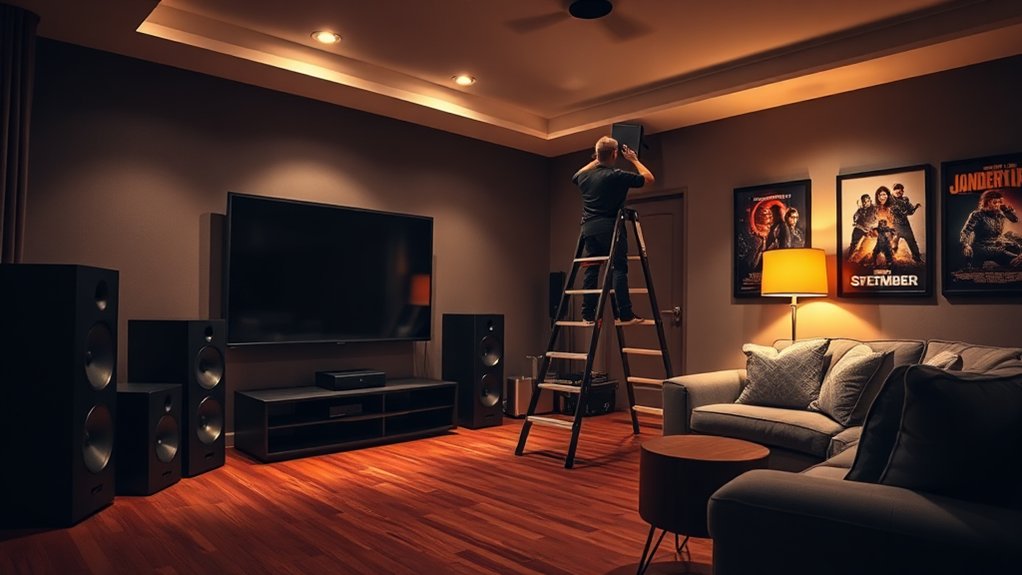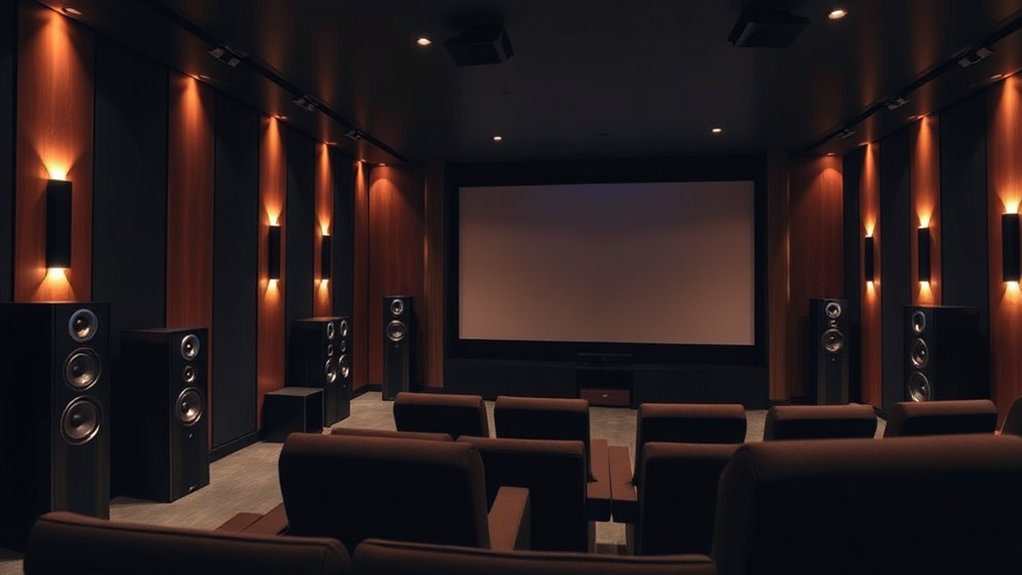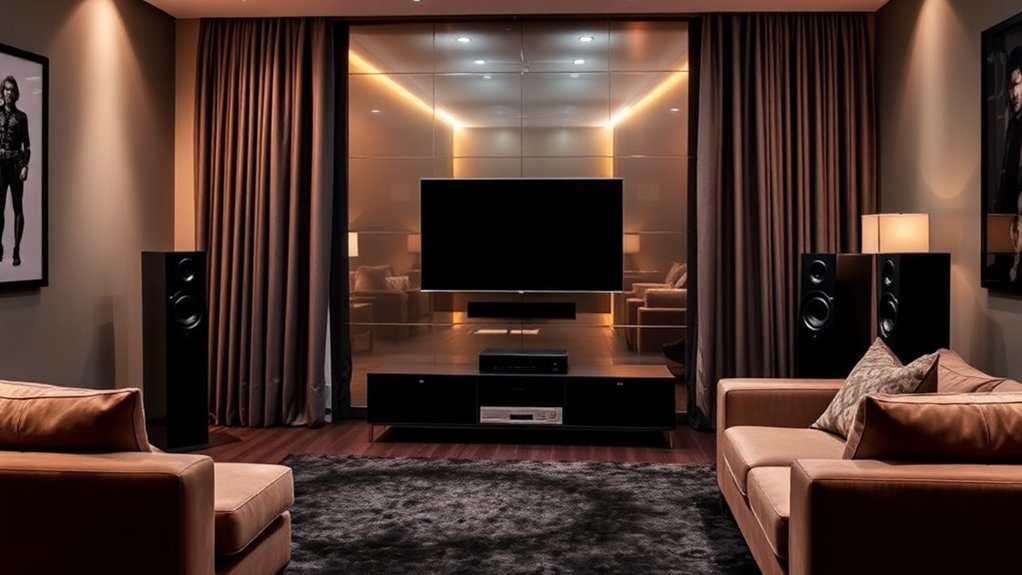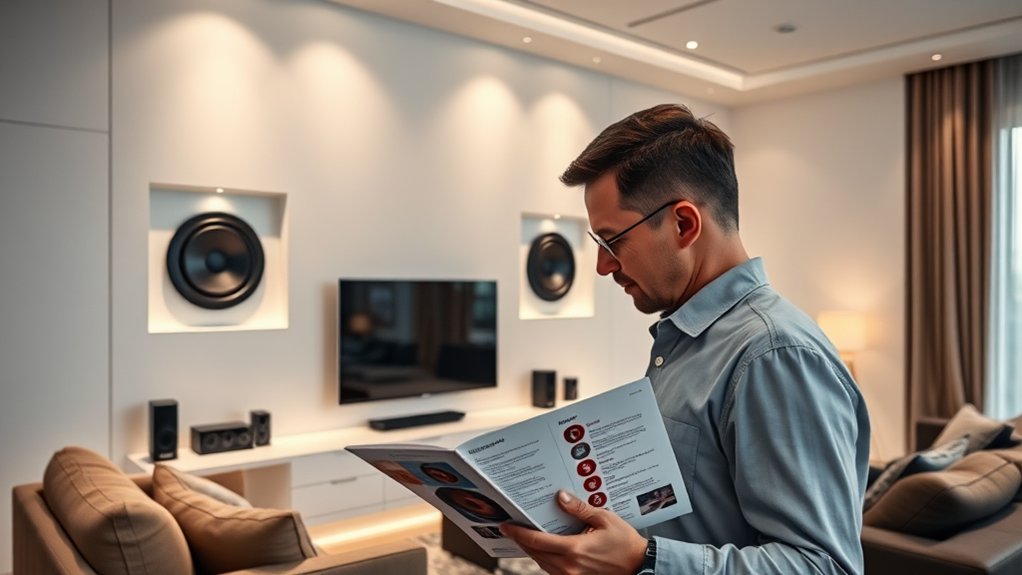To install professional home theater speakers, start by placing your front speakers equidistant from each other and your listening position—this creates a wider soundstage. Opt for wall mounts to position surround speakers slightly above ear level for that immersive experience (who wouldn’t want to feel like they’re in the movie?). Use quality wire and check connections for proper polarity, then calibrate your system for balanced sound. Stick around, and you’ll pick up tips on optimizing Dolby Atmos setups next!
Key Highlights
- Ensure front speakers are equidistant from each other and the listening position for an optimal soundstage.
- Mount surround speakers slightly above ear level and away from reflective surfaces to enhance immersion and clarity.
- Use appropriate gauge wiring and maintain proper polarity to ensure the best audio performance.
- Position overhead or upward-firing Dolby Atmos speakers for effective sound placement directly above the listening area.
- Calibrate the sound system using automatic features to achieve balanced output and adjust speaker settings for optimal audio quality.
Understanding Speaker Placement Fundamentals
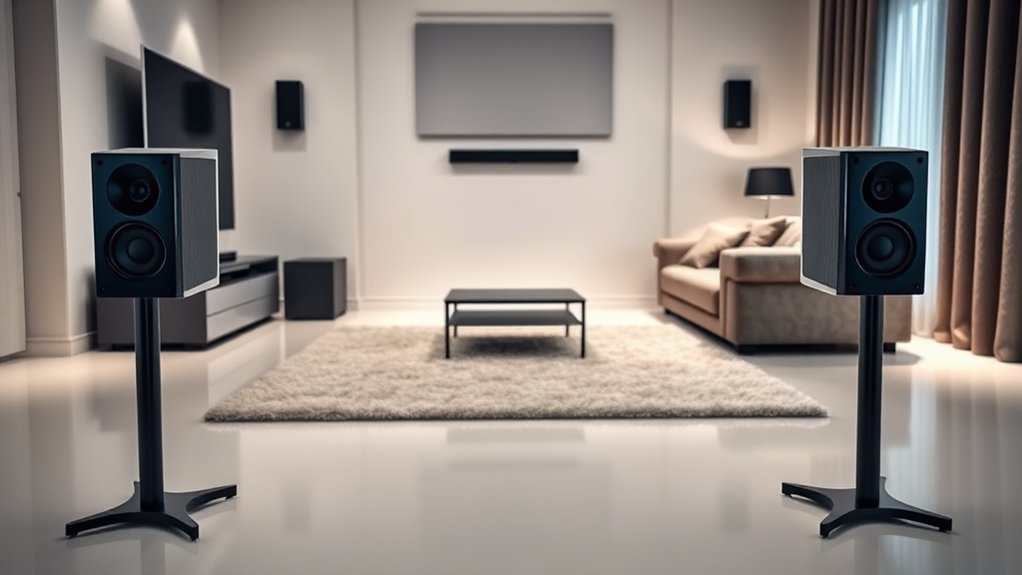
When setting up your home theater, think of speaker placement like arranging furniture in a living room; you want everything to have its perfect spot to create a comfortable and enjoyable atmosphere.
Start with your front speakers, aiming for them to be equidistant from each other and your main listening position. This spacing establishes a wide soundstage, enhancing your audio experience. Position them slightly away from the rear walls for better bass response, as you keep tweeters at ear level for clear high frequencies. Understanding basic room acoustics, like how hard surfaces reflect sound, helps you sidestep echoes and maximize clarity. Additionally, incorporating acoustic treatment options such as bass traps and diffusers can further improve the overall sound quality in your home theater setup. Regularly checking speaker placement ensures that sound remains balanced and immersive. High-performance speakers are essential for achieving this goal and can significantly elevate your dynamic audio quality experience.
Position your front speakers equidistant from each other and your listening spot for an immersive soundstage and optimal clarity.
Don’t forget to angle those speakers inward towards your sweet spot—this toe-in technique improves image focus.
Choosing Mounting and Placement Options
Choosing the right mounting and placement options for your home theater speakers can greatly improve your overall audio experience, and it’s not just about slapping them up on the wall.
You’ll want to take into account wall mounts or specialized brackets that can tilt and pivot, allowing for ideal speaker angles. Ideally, mount surround speakers slightly above ear level for the best immersion. Additionally, consider using speaker mounting brackets to ensure a secure installation that supports both horizontal and vertical orientations. Just imagine having your speakers hide in plain sight while performing like rock stars! Furthermore, pay attention to acoustics—steer clear of reflective surfaces that might muddy your sound. To optimize your setup, make sure to use high-resolution audio tracks for enhanced sound quality during playback. The Sonos Arc is an excellent option if you’re looking for a premium sound experience that supports various audio formats.
Don’t forget, the structural integrity of your wall matters too; after all, you wouldn’t want your speakers crashing down mid-movie. With thoughtful placement, your audio can truly shine!
Ensuring Proper Wiring and Connections
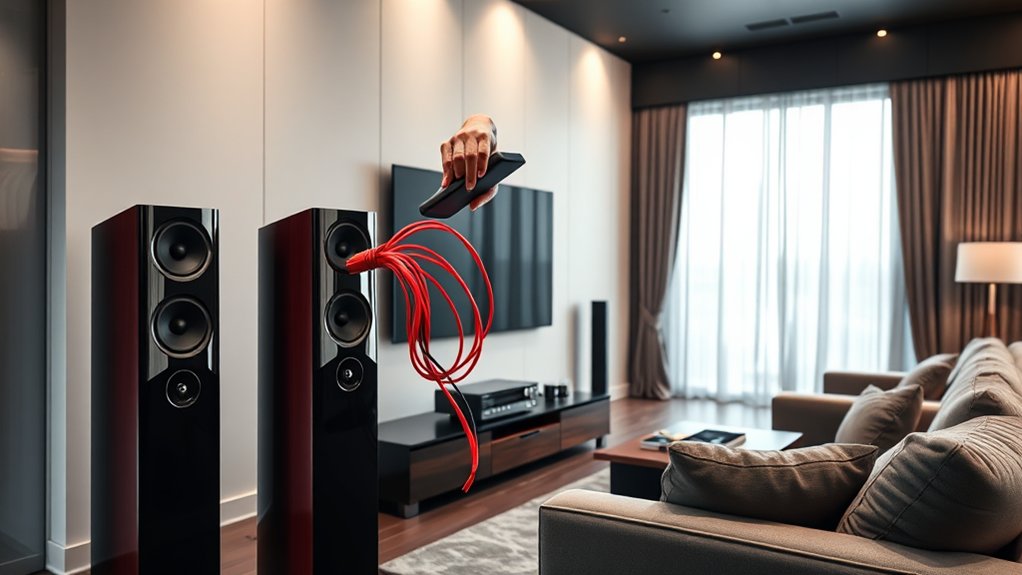
Getting the wiring and connections right for your home theater speakers really ties everything together, ensuring you catch every bass drop and subtle whisper in your favorite films.
Start with selecting the right gauge wire—16-gauge works well for runs up to 50 feet, whereas 14-gauge handles longer distances. Use oxygen-free copper if you can; it’s like giving your sound a spa day! 14 gauge speaker wire is recommended for long runs, ensuring optimal audio quality. Additionally, ensure that your speaker wire supports immersive audio technologies, as this will further enhance your overall sound experience.
Choosing the right gauge wire is essential—16-gauge for up to 50 feet, 14-gauge for longer runs. Treat your sound to oxygen-free copper!
As you run the wires, plan their routes to avoid unsightly tangles later. Keep wire lengths uniform within each channel to eliminate annoying phase issues.
When connecting, maintain proper polarity—red goes to red, black to black. Tighten your connections, but don’t overdo it; you aren’t trying to win an arm wrestling match!
Happy wiring!
Configuring Dolby Atmos Speakers for Immersion
Configuring Dolby Atmos speakers can feel like trying to solve a complex puzzle, but with the right approach, you’ll set up an immersive audio experience that’ll transport you right into your favorite movies or concerts.
Start by placing overhead speakers directly above, and slightly in front of your main listening position. If you’re using upward-firing modules, position them on top of your front or rear speakers, ensuring they’re angled just right for sound reflection.
Don’t forget, assigning proper speaker sizes in your AV receiver—small for those lacking bass, and large for full-range speakers—can make a significant difference. Additionally, ensure that your setup takes advantage of object-based audio rendering, as this feature allows for precise sound placement, enhancing your listening experience.
Think of it like tailoring your audio, ensuring every nuance hits just right. Ready to plunge into this? Let’s lift those sound waves!
Calibrating and Fine Tuning Your Sound System

Once you’ve set up your Dolby Atmos speakers for that surround-sound experience, it’s time to guarantee every note and effect comes through just right.
Start with speaker level calibration; aim for a balanced output around 75 dB, using a sound level meter at ear height. Your AV receiver’s automatic calibration feature can be a lifesaver, measuring distance and delay, ensuring everything’s in sync.
If you’re feeling hands-on, manually tweak speaker sizes, crossover frequencies, or time delays to fit your space. Don’t forget about acoustics—soft furnishings can soften harsh reflections, whereas positioning away from walls reduces phase issues. Additionally, incorporating advanced audio technologies like those found in models such as the Denon DHT-S517 can further enhance your audio experience.
Finally, test various audio content to identify areas needing adjustment; isn’t it great when your system delivers a perfectly tuned experience?
Frequently Asked Questions
Can I Mix Different Brands of Speakers Together?
Yes, you can mix different brands of speakers, but keep in mind potential tonal mismatches and compatibility issues. It’s best to match impedance and sensitivity to avoid uneven sound and guarantee a balanced audio experience.
How Do I Avoid Interference From Nearby Electronics?
To avoid interference from nearby electronics, keep your audio cables away from power cords, use high-quality, shielded cables, and identify noise sources like dimmer switches or fluorescent lamps, ensuring a clean sound environment.
What if My Room Has an Unusual Shape?
If your room has an unusual shape, focus on speaker placement. Position them to form an equilateral triangle with your seating, keeping them away from walls and angling them to accommodate the space’s unique acoustics.
Should I Use Wired or Wireless Speakers?
When deciding between wired or wireless speakers, consider your preferences. Wired speakers offer superior sound quality and stability, whereas wireless systems provide convenience and flexibility. Evaluate your space and prioritize what matters most for your setup.
How Often Should I Recalibrate My Audio System?
You should recalibrate your audio system every 6 to 12 months, especially after moving speakers or furniture. Additionally, recalibrate whenever you add new components or notice sound imbalances for peak performance.

